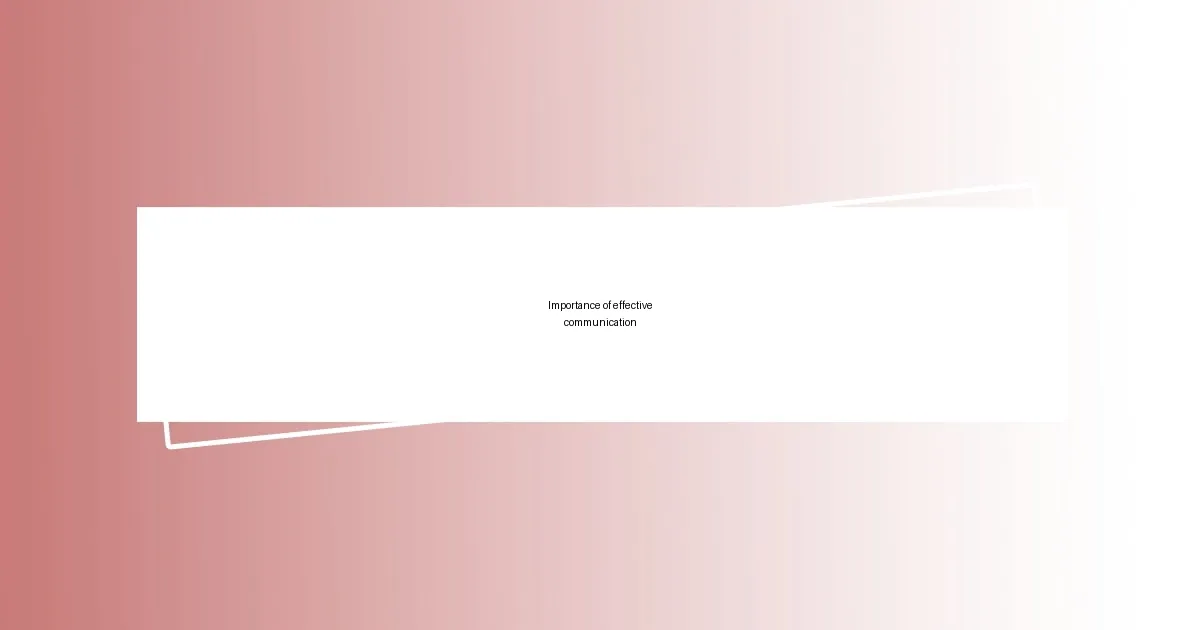Key takeaways:
- Understanding team dynamics involves empathy, communication, and trust, which are essential for effective collaboration and creativity.
- Effective communication fosters trust, enhances problem-solving, boosts morale, reduces conflict, and increases efficiency within teams.
- Recognizing and clarifying individual roles and strengths within a team improves accountability and enhances overall project quality.
- Creating a culture of trust and managing conflict with empathy can lead to innovative solutions and strengthen team cohesion.

Understanding team dynamics
Understanding team dynamics is more than just recognizing who does what; it’s about grasping how personalities interact and influence one another. I remember a time when our team faced a particularly challenging project. At first, there was friction because of differing work styles, but as we took the time to understand each other’s strengths and weaknesses, we discovered a rhythm that worked for all of us. How often do we overlook the power of empathy in a team setting?
Diving deeper, it becomes clear that communication is the lifeline of any dynamic team. I once had a teammate who was a fantastic problem solver but struggled to voice their ideas during meetings. Once we created an environment where everyone felt safe to speak up, the whole group’s creativity seemed to flourish. Isn’t it fascinating how a simple shift in communication can spark innovation?
Furthermore, I’ve seen firsthand how trust shapes team dynamics. In a previous role, our team underwent some major changes, and the lack of trust led to skepticism and hesitance. Trust isn’t just something you assume; it has to be cultivated actively. Can you recall a moment when trust transformed a project for you? It’s these moments that remind us that understanding team dynamics goes beyond strategy; it’s fundamentally about people connecting and collaborating meaningfully.

Importance of effective communication
Effective communication is often the unsung hero of team dynamics. I recall an instance when a project of ours began to unravel simply because team members were interpreting the same goals differently. By initiating open discussions, we were able to unravel those misunderstandings and align our perspectives. It became clear to me that clarity in communication not only enhances collaboration but also fuels motivation.
Here’s why effective communication is crucial for teams:
- Fosters Trust: When team members communicate openly, it builds a sense of safety and trust.
- Enhances Problem-Solving: Clear communication allows diverse ideas to surface, enriching the problem-solving process.
- Boosts Morale: When people feel heard, their engagement and enthusiasm increase.
- Reduces Conflict: Misunderstandings can escalate into disputes, but effective communication helps mitigate that risk.
- Increases Efficiency: Teams that communicate well are often more productive, as alignment reduces wasted effort.
Reflecting on these points, I understand how communication serves not just as a tool but as the very glue binding a team together.

Recognizing roles within teams
Recognizing roles within teams is crucial to harnessing a team’s full potential. I’ve often found that individuals can sometimes merge roles unintentionally, which can lead to confusion. For instance, in one project I worked on, our dedicated planner would often take on tasks that weren’t originally theirs, inadvertently leading to tension among the group. When we clarified our individual roles and responsibilities, it became much easier to hold each other accountable while also celebrating our collective achievements. Understanding who is doing what can dramatically enhance efficiency.
It’s fascinating how diverse roles can complement one another. In another instance, our team’s designer and writer had a bit of a rocky start. They approached their work from completely different angles, which initially led to misunderstandings. However, once we recognized that the designer’s creative vision needed the writer’s narrative flow for a cohesive presentation, both began to appreciate the importance of each other’s contributions. This realization not only improved their collaboration but also elevated the overall quality of our project.
To truly thrive as a unit, acknowledging the unique strengths each member brings is essential. I recall leading a team where we each shared our skills openly, creating a ‘strengths matrix.’ This simple exercise revealed untapped talents; one member, whom I thought was merely organized, turned out to have remarkable analytical skills that helped us pivot our strategy effectively during a crucial phase. When team members’ roles are recognized and leveraged, everyone feels more engaged and empowered.
| Team Role | Characteristics |
|---|---|
| Leader | Guides, motivates, and coordinates the team. |
| Innovator | Generates creative ideas and encourages brainstorming. |
| Analyzer | Evaluates information and assesses risks effectively. |
| Supporter | Provides encouragement and helps maintain team morale. |
| Implementer | Turns ideas into tangible actions and ensures tasks are completed. |

Creating a culture of trust
Creating a culture of trust is a game-changer for any team, and I’ve seen its profound effects firsthand. When I joined a new team, we kicked off with an innovative icebreaker that encouraged vulnerability. We shared personal stories, and that openness laid the groundwork for trust. I believe that when people feel safe to express their thoughts and ideas without fear of judgment, they flourish.
During a particularly challenging project, I witnessed the power of trust in action. Our team faced tight deadlines, and tensions ran high. Yet, because we had built a trusting environment, team members openly communicated their struggles and offered help when needed. This genuine support not only lightened the load but also inspired creativity; we brainstormed solutions together that none of us would have thought of alone. Isn’t it amazing how a solid foundation of trust can unlock such potential?
I keep reflecting on how essential trust is, especially in remote work settings. It’s easy to feel isolated and disconnected when you can’t see your teammates daily. Last year, I facilitated virtual check-ins where we discussed personal wins and challenges. Surprisingly, this simple practice strengthened our bonds and fostered a team where everyone felt valued. In my experience, it’s these small yet meaningful gestures that cultivate a lasting culture of trust. How do you think your team could benefit from building more trust?

Managing conflict in teams
Managing conflict in teams often requires a delicate touch, and I’ve learned that addressing issues early can prevent escalation. In one memorable project, I noticed two teammates clashed frequently on strategy decisions. By suggesting a neutral ground discussion, we could air grievances constructively. This not only defused the tension but also fostered a greater understanding of each other’s perspectives.
I remember a time when I found myself caught in the middle of a disagreement between two strong-willed individuals. Instead of sides, I encouraged a brainstorming session where we explored solutions collaboratively. The transformation was incredible; what started as friction turned into a powerful synergy where ideas flowed freely. Isn’t it fascinating how conflict, when managed well, can pave the way for creativity to emerge?
It’s essential to approach conflict with empathy. In a past experience, I had a team member whose stress was evident during discussions. I reached out for a one-on-one chat, and it turned out that personal issues were affecting their performance. By providing support and flexibility, we not only managed to resolve the conflict but also strengthened our team cohesion. How often do we remember that behind every disagreement, there’s a story that deserves to be heard?

Strategies for team collaboration

Strategies for team collaboration
One effective strategy for fostering collaboration is establishing regular check-ins that go beyond mere status updates. There was a time when my team struggled with miscommunication during project sprints. By introducing brief, daily stand-up meetings, we not only aligned our goals but also created a space for real-time feedback. It was in those moments I noticed how asking for input can energize the group, making everyone feel involved and valued. So, how often does your team truly connect during these meetings?
Another approach I find invaluable is leveraging diverse skill sets within the team. I recall a project where I encouraged team members to lead discussions based on their expertise. This not only empowered individuals but also cultivated an environment where learning was part of our culture. When everyone brings their unique perspective to the table, it creates a rich tapestry of ideas that can spark innovation. Have you considered who on your team could shine if given the opportunity to take the lead in discussions?
Encouraging a sense of ownership is also crucial in enhancing collaboration. In a recent initiative, I allowed team members to choose their roles within a project based on their strengths and interests. This not only boosted morale but initiated a collaborative spirit where everyone felt personally invested. When individuals take responsibility for their contributions, it fosters pride in teamwork. How might shifting ownership within your team impact the overall dynamic and productivity?

Evaluating team performance
Evaluating team performance is more than just assessing productivity; it involves understanding the nuances of collaboration and individual contributions. I remember a specific team project where I initiated a feedback loop after each milestone. This not only revealed gaps in our processes but also allowed team members to voice their insights. The joy of seeing someone light up when their suggestions were acknowledged reinforced my belief in the power of evaluation as a tool for growth.
Another observation I’ve made is that performance metrics alone can’t capture the true essence of a team’s health. During one particularly intense project, we measured success by deliverables but overlooked how team morale was fluctuating. Reflecting on our dynamics revealed that the pressure was stifling creativity. If we only focus on numbers, are we risking the very connections that fuel innovation? That experience taught me the importance of evaluating not just what we accomplish, but how we feel while doing it.
I also advocate for incorporating peer evaluations as part of the assessment. In a team I worked with, we created an open forum where everyone could share their thoughts on each other’s contributions. This practice unveiled hidden strengths, as well as areas for improvement, leading to candid conversations brimming with emotional insights. Have you ever felt surprised by the impact your teammates think you make? It’s a powerful way to align visions and enhance both individual growth and team cohesion, turning evaluation into a shared journey rather than just a critique.














